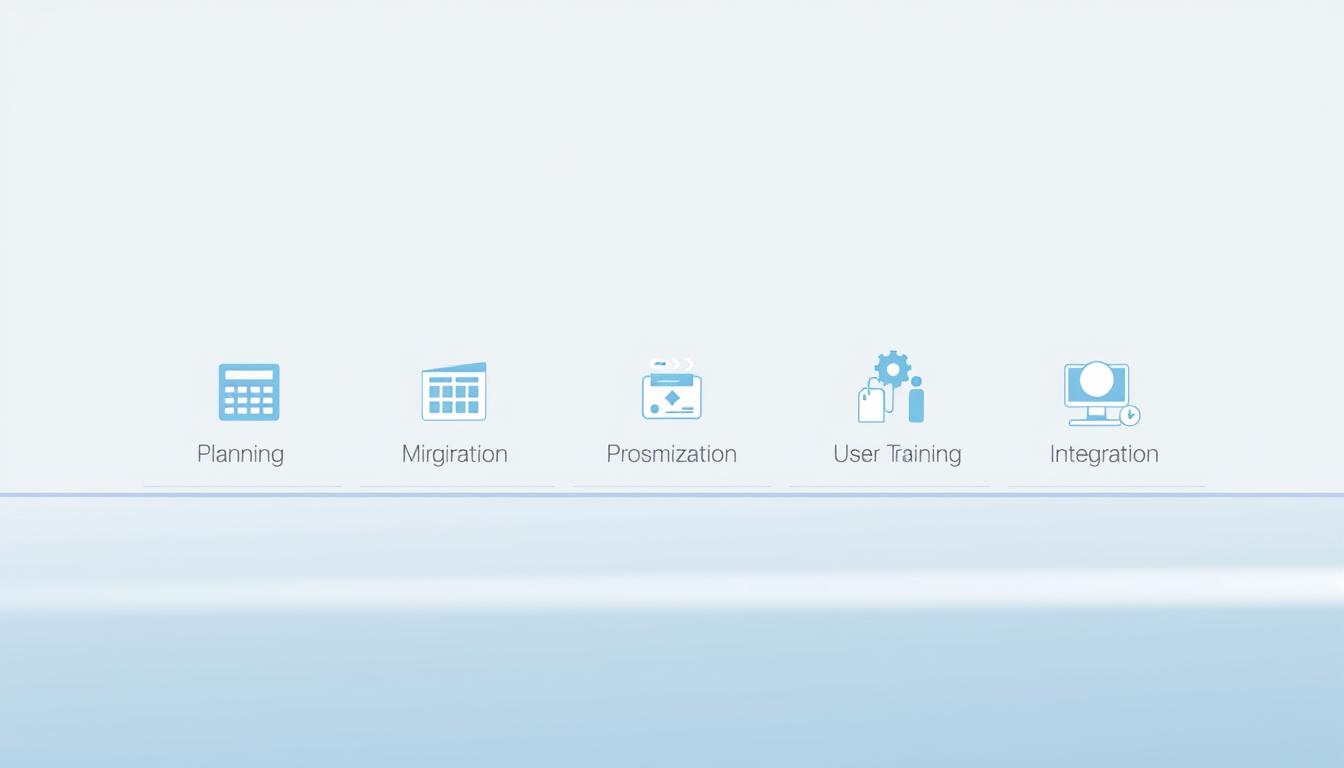Did you know that companies using CRM systems can boost sales by up to 29%? Good customer relationship management is key for lasting business success. It involves gathering and analyzing data to handle current and future customer interactions.
CRM has grown a lot over the years. It’s now a vital tool for business growth. This guide will show you the CRM implementation steps and the customer relationship management process. You’ll learn how to use these strategies for your business.
Key Takeaways
- Understanding the importance of CRM in business growth.
- Learning the steps involved in CRM implementation.
- Gaining insights into effective customer relationship management.
- Discovering how CRM can improve sales and customer satisfaction.
- Exploring strategies for successful CRM adoption.
Understanding Customer Relationship Management
Businesses are changing fast, and so is the role of Customer Relationship Management (CRM). CRM helps manage customer data and interactions. It uses data to make customers happier and more loyal.
Definition and Importance
CRM is about managing customer interactions and data. It helps businesses understand their customers better. This leads to better processes and more profit.
With CRM, companies can see their customers clearly. This lets them offer personalized experiences. It builds stronger customer relationships, leading to happier customers and more sales.
Key Components of CRM
CRM has three main parts: sales, marketing, and customer service. Each is vital for managing customer interactions well.
| Component | Description | Benefits |
|---|---|---|
| Sales | Manages sales processes, including lead tracking and conversion. | Improved sales forecasting, enhanced customer insights. |
| Marketing | Facilitates targeted marketing campaigns and customer engagement. | Increased campaign effectiveness, better customer targeting. |
| Customer Service | Provides tools for managing customer support and service requests. | Enhanced customer satisfaction, reduced response times. |
Good customer data management is key to CRM success. CRM systems keep customer data accurate and up-to-date. This helps the whole organization work better together.
Benefits of a Strong CRM Process
A strong CRM process is key to any successful customer engagement strategy. It helps manage customer interactions, building deeper relationships and driving growth. Let’s look at the main benefits of a robust CRM system.
Improved Customer Satisfaction
One big plus of a strong CRM process is improving customer experience. CRM data helps businesses understand what customers want and like. This lets them offer personalized services that meet and exceed expectations.
For example, a CRM system tracks customer interactions. This helps businesses tailor their services to fit customer needs.
- Personalized marketing campaigns based on customer behavior
- Timely and effective customer support
- Tailored product recommendations
By focusing on these areas, businesses can boost customer satisfaction. This leads to more loyal and retained customers.
Enhanced Communication
Good communication is key to strong customer relationships. A strong CRM process makes enhanced communication easier by centralizing customer data. This keeps businesses up-to-date on customer interactions and preferences.
Some benefits of better communication include:
- Improved response times to customer inquiries
- More targeted and relevant marketing messages
- Better alignment between sales and marketing teams
Increased Sales Opportunities
A well-implemented CRM process can also boost increased sales opportunities. By analyzing customer data, businesses can find new sales prospects. CRM systems also help sales teams manage their pipelines better, ensuring no potential sales are missed.
To make the most of sales opportunities, businesses should:
- Leverage CRM data to find new sales prospects
- Develop targeted sales strategies
- Ensure smooth collaboration between sales and marketing teams
By using these strategies, businesses can grow their revenue and get a better return on their CRM investment.
The Customer Relationship Management Process Overview
The CRM process has several key steps to build strong customer relationships. By following these steps, businesses can boost customer satisfaction and sales. They also improve communication with their customers.
Steps in the CRM Process
The CRM process includes collecting, analyzing, and using customer data. Here are the main steps:
- Data Collection: Gathering customer data from social media, feedback, and sales.
- Data Analysis: Studying the data to understand customer behavior and preferences.
- Strategy Implementation: Creating and using strategies based on the data analysis.
By following these steps, businesses can build a strong CRM process. This process helps keep customers loyal. For more on CRM, visit Smart Client Manager.
Insights from Data Collection
Data collection is key in the CRM process. It gives businesses insights into customer behavior and preferences. By analyzing data, companies can spot trends and areas for improvement.
| Data Collection Method | Description | Benefits |
|---|---|---|
| Social Media Monitoring | Tracking customer interactions on social media platforms | Provides real-time feedback, helps identify customer concerns |
| Customer Feedback Surveys | Collecting feedback through surveys and questionnaires | Helps understand customer satisfaction, identifies areas for improvement |
| Sales Interaction Analysis | Analyzing sales interactions to understand customer behavior | Provides insights into customer preferences, helps tailor sales strategies |
Using these insights, businesses can create targeted marketing strategies. This improves customer engagement. Effective CRM practices, like regular data analysis, help achieve client retention goals.
Choosing the Right CRM Software
Businesses need to pick the right CRM software for their needs. There are many CRM tools and workflow solutions out there. It’s important to choose wisely to improve customer interactions and grow your business.
There are many CRM software options, like Zendesk Sell and Sage CRM. Each has its own features and benefits. When picking a CRM system, consider a few key things.
Popular CRM Tools for Businesses
Popular CRM tools help manage customer relationships better. For example, Zendesk Sell helps with sales, leads, and pipelines. It’s great for sales teams.
Sage CRM offers more, like marketing and customer service management. It’s good for businesses looking for a full CRM solution.
| CRM Tool | Key Features | Target Users |
|---|---|---|
| Zendesk Sell | Sales force automation, lead management, pipeline management | Sales teams |
| Sage CRM | Marketing automation, customer service management, sales management | Businesses seeking comprehensive CRM solutions |
Factors to Consider When Selecting Software
When picking CRM software, think about a few things. Make sure it’s easy to use and fits your business. Also, check if it can grow with your business.
- Ease of implementation and user adoption
- Customization options to fit your business processes
- Integration with existing tools and systems
- Scalability to accommodate business growth
- Customer support and training provided by the vendor
By looking at these factors and checking out popular CRM tools, you can make a smart choice. This will help you manage customer relationships better and grow your business.
Implementing a CRM Strategy
Effective CRM implementation is crucial for businesses. It involves setting clear goals and training employees well.
Setting Clear Goals
Before starting a CRM system, define your goals. This means identifying your CRM objectives and making sure they match your business strategy. Clear goals help you measure CRM success and make changes if needed. For more on CRM strategy, check out Salesforce’s CRM Strategy page.
Goals could be to boost customer satisfaction, increase sales, or better engage customers. These goals should be specific, measurable, achievable, relevant, and time-bound (SMART).
Training Employees
Training employees is vital in CRM implementation. They need to know how to use the CRM system well. This includes basic and advanced features.
Effective training boosts employee productivity and ensures accurate customer data use. It’s also key to offer ongoing support as employees use the CRM system.
By focusing on these areas, businesses can achieve a successful CRM implementation. This meets their customer data management needs and improves their CRM steps.
Data Management in CRM
Accurate data is key to a good CRM system. In today’s world, managing customer data well is essential. It helps improve customer experience and grow the business.
Importance of Accurate Data
Having the right data is crucial for smart decisions and better customer service. Wrong data can lead to bad strategies and unhappy customers.
“Data is the new oil. It’s valuable, but if not refined, it can’t be used effectively.”
To get the most from CRM, keeping data accurate is a must. This means cleaning, checking, and organizing customer info regularly.
Methods for Data Collection
There are many ways to get customer data. These include:
- Surveys and feedback forms
- Social media monitoring
- Customer interactions and transactions
- Website analytics
Using these methods helps businesses understand what customers want. This lets them create strong customer engagement strategies.
| Data Collection Method | Description | Benefits |
|---|---|---|
| Surveys and Feedback Forms | Collecting direct feedback from customers through surveys and forms on websites or mobile apps. | Provides insights into customer satisfaction and preferences. |
| Social Media Monitoring | Tracking customer interactions and mentions on social media platforms. | Helps in understanding customer sentiment and behavior. |
| Customer Interactions and Transactions | Recording customer interactions and transactions across various touchpoints. | Enables personalized marketing and improves customer service. |

In conclusion, managing data well is vital for CRM success. By focusing on accurate data and using different ways to collect it, businesses can improve their customer strategies and grow over time.
Customer Engagement Techniques
To keep customers coming back, businesses need strong engagement strategies. Understanding what customers want is key to building lasting relationships. CRM best practices help improve satisfaction and keep clients loyal.
Personalized Marketing Strategies
Personalized marketing is vital for engaging customers. CRM data helps tailor marketing to fit each customer’s needs. This approach boosts the chances of successful interactions.
- Segmenting customer bases to target specific groups
- Using customer data to create personalized offers
- Implementing marketing automation tools to streamline processes
Effective Customer Support
Good customer support is essential for engagement. Quick and helpful service can make customers happier and more loyal.
- Implementing multi-channel support systems (e.g., phone, email, chat)
- Training support staff to be knowledgeable and empathetic
- Utilizing CRM data to provide personalized support
Measuring CRM Success
It’s key to measure CRM success to see how our customer engagement efforts are doing. We track and analyze important metrics to see how well our CRM strategies are working.
Key Performance Indicators (KPIs)
Key Performance Indicators (KPIs) help us check if our CRM plans are succeeding. Important KPIs include customer retention rates, sales growth, and how happy our customers are. By watching these KPIs, we can find what needs work and make our CRM better.
If our customer retention rate is going down, we can use CRM tools to make our customer interactions more personal. If our sales aren’t growing, we can look at how we manage customer data to find ways to do better.
Customer Feedback and Surveys
Customer feedback and surveys also give us important insights. By asking for feedback through surveys and social media, we learn what our customers want and need. This helps us make smart choices to improve our CRM efforts.
We can use feedback to spot problems in our customer support and make it better. With CRM tools, we can also make collecting feedback easier and respond faster to customer concerns.

By looking at KPIs and customer feedback together, we get a full view of our CRM success. This helps us make better choices to keep improving.
Challenges in Customer Relationship Management
The journey to successful CRM implementation is filled with potential hurdles. Businesses aim to boost their customer engagement strategies but often face obstacles. These challenges can slow down their progress.
Common Roadblocks and Solutions
Data quality issues are a major challenge. Inaccurate or incomplete data can lead to poor decisions and a failed CRM strategy. To tackle this, businesses need to focus on data validation and ensure their data collection methods are effective.
Another big hurdle is resistance to change from employees. To overcome this, businesses should invest in comprehensive training. By teaching employees about CRM’s benefits and proper use, they can create a more open environment for CRM adoption.
- Data quality issues
- Resistance to change
- Insufficient training
- Poor integration with existing systems
For more insights on CRM challenges, visit CIO Insight. They offer a detailed look at common CRM challenges and possible solutions.
Adapting to Market Changes
Market dynamics are always changing, and businesses need to be quick to adapt. CRM systems are key in this, providing real-time data and insights. This helps businesses adjust their strategies and improve customer experience.
“The key to successful CRM is not just about the technology, but about understanding your customers and adapting to their changing needs.”
To stay ahead, businesses should focus on improving customer experience. This can be done through personalized marketing and effective customer support. By doing so, they can build stronger customer relationships and drive growth.
The Future of CRM Technology
The CRM world is changing fast, with new tech making customer experiences better. As more businesses use CRM systems, the tech gets smarter. This is thanks to AI, automation, and better data analysis.
AI and machine learning are big in CRM’s future. They help businesses understand lots of customer data. This gives insights that make CRM implementation steps better and boost customer interaction.
Trends to Watch in the CRM Space
Several trends will shape CRM in the next few years. These include:
- Enhanced personalization through AI-driven analytics
- Increased use of automation in CRM workflows
- Greater emphasis on customer experience through omnichannel engagement
As CRM tech evolves, businesses must update their CRM workflow. This might mean getting new software, training staff, and improving data handling.
The Role of AI in CRM
AI will be key in CRM’s future. It helps automate tasks, understand customer behavior better, and craft better marketing plans.
| AI Application | Benefits |
|---|---|
| Predictive Analytics | Improved forecasting and decision-making |
| Chatbots and Virtual Assistants | Enhanced customer support and engagement |
| Personalized Marketing | Increased customer satisfaction and loyalty |
Looking ahead, CRM tech will keep shaping business strategies and how we interact with customers. By keeping up with new trends and tech, businesses can stay ahead and offer top-notch customer experiences.
Final Thoughts on Effective CRM
As we wrap up our guide on Effective Customer Relationship Management, it’s clear CRM is key. It helps drive customer satisfaction and loyalty. By using CRM best practices, businesses can keep customers coming back and build lasting relationships.
Recap of Key Takeaways
In this guide, we covered the basics of CRM. This includes managing data, engaging with customers, and measuring success. We also talked about picking the right CRM software and creating a strategy that fits your business goals.
Encouraging Continuous Improvement
Good CRM means always getting better and adapting to what customers want. By regularly checking and improving your CRM strategy, you can outdo your rivals and grow your business. This means using smart tactics to keep customers and staying current with CRM trends to keep them happy and loyal.



